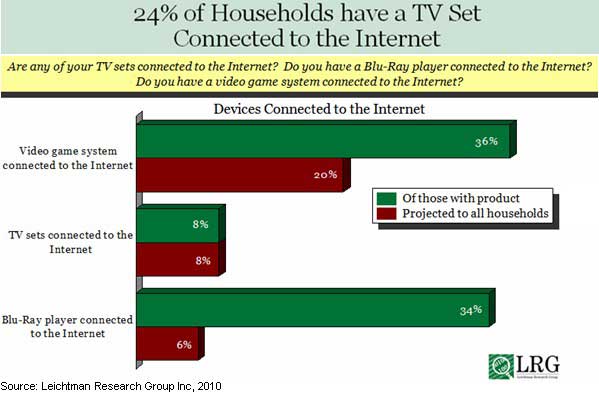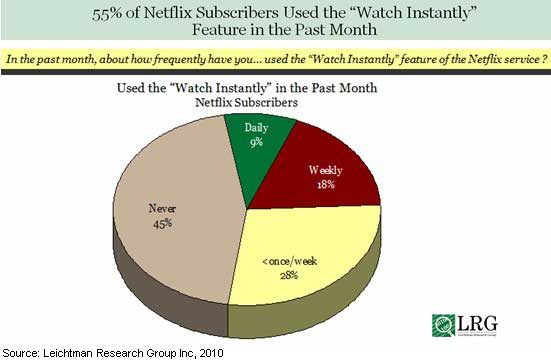The adoption of Web-to-TV viewing is in its early stages but is slowly gaining market traction: 24% of US households have a television connected to the Internet, and the most popular types of connections are via videogame consoles, Blue-Ray systems, and Internet TVs, according to a survey from Leichtman Research Group.
But traditional television is still a mainstay of most households—contrary to speculation that alternative (e.g., Internet TV) viewing will soon displace cable or satellite TV.
Among households with a TV connected to the Internet, 20% are using a videogame system, 8% have a Web-connected TV set, and 6% use a Blu-Ray player with Internet capabilities (some households are connected to one or more of such devices).

Although Internet connectivity is becoming a common built-in feature in electronics devices, consumers are just beginning to use the capability to watch video online: Just 1% of all online adults watch video from the Internet via TV on a daily basis, and 5% watch it weekly.
Such use is skewed toward a young and male demographic: 16% of men age 18-34 watch online video via TV on a weekly basis.
Looking for great digital marketing data? MarketingProfs reviewed more than 200 research sources and selected 64 of the best to create the Digital Marketing Factbook a 144-page compilation of data and 110 charts, covering email marketing, search engine marketing, and social media. Also check out The State of Social Media Marketing, a 240-page original research report from MarketingProfs.
Instant Watching
Over one-half (55%) of consumers surveyed who subscribe to Netflix say they used the "Watch Instantly" feature during the previous month. Among those consumers, 9% used the feature daily, 18% used it weekly, and 28% who used it less than once a week.

However, among all adults, just 1% use the Netflix "Watch Instantly" feature daily, and 4% use it weekly.
Overall, 3% of all adults watch a full-length TV show online daily, and 11% do so weekly.
Cable TV Still Strong
Only 4% of all online adults would consider disconnecting their TV service to just watch video online—compared with 3% who said so last year.
In addition, just 5% of online adults strongly agree they would be willing to pay $9.95 per month to watch TV shows online from a service like Hulu, while 81% strongly disagree.
About the data: The findings are from the Emerging Video Services IV, LRG's fourth annual nationwide study investigating non-TV-based video services (including online, iPods/portable media players, mobile phones, and devices connected to the Internet). The survey, conducted in December 2009, is based on a telephone survey of 1,250 adults age 18+ from throughout the continental US in households that have a TV set.



